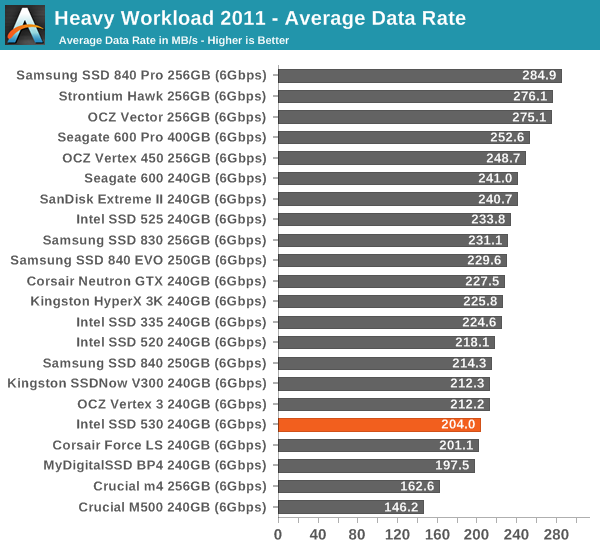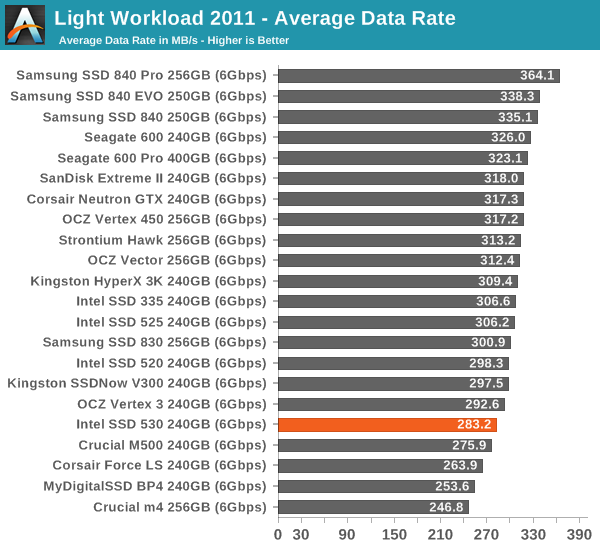Intel SSD 530 (240GB) Review
by Kristian Vättö on November 15, 2013 1:45 PM EST- Posted in
- Storage
- SSDs
- Intel
- Intel SSD 530
AnandTech Storage Bench 2011
Two years ago we introduced our AnandTech Storage Bench, a suite of benchmarks that took traces of real OS/application usage and played them back in a repeatable manner. Anand assembled the traces out of frustration with the majority of what we have today in terms of SSD benchmarks.
Although the AnandTech Storage Bench tests did a good job of characterizing SSD performance, they weren't stressful enough. All of the tests performed less than 10GB of reads/writes and typically involved only 4GB of writes specifically. That's not even enough exceed the spare area on most SSDs. Most canned SSD benchmarks don't even come close to writing a single gigabyte of data, but that doesn't mean that simply writing 4GB is acceptable.
Originally I kept the benchmarks short enough that they wouldn't be a burden to run (~30 minutes) but long enough that they were representative of what a power user might do with their system.
Not too long ago I tweeted that I had created what I referred to as the Mother of All SSD Benchmarks (MOASB). Rather than only writing 4GB of data to the drive, this benchmark writes 106.32GB. It's the load you'd put on a drive after nearly two weeks of constant usage. And it takes a *long* time to run.
1) The MOASB, officially called AnandTech Storage Bench 2011 - Heavy Workload, mainly focuses on the times when your I/O activity is the highest. There is a lot of downloading and application installing that happens during the course of this test. My thinking was that it's during application installs, file copies, downloading and multitasking with all of this that you can really notice performance differences between drives.
2) I tried to cover as many bases as possible with the software I incorporated into this test. There's a lot of photo editing in Photoshop, HTML editing in Dreamweaver, web browsing, game playing/level loading (Starcraft II & WoW are both a part of the test) as well as general use stuff (application installing, virus scanning). I included a large amount of email downloading, document creation and editing as well. To top it all off I even use Visual Studio 2008 to build Chromium during the test.
The test has 2,168,893 read operations and 1,783,447 write operations. The IO breakdown is as follows:
| AnandTech Storage Bench 2011 - Heavy Workload IO Breakdown | ||||
| IO Size | % of Total | |||
| 4KB | 28% | |||
| 16KB | 10% | |||
| 32KB | 10% | |||
| 64KB | 4% | |||
Only 42% of all operations are sequential, the rest range from pseudo to fully random (with most falling in the pseudo-random category). Average queue depth is 4.625 IOs, with 59% of operations taking place in an IO queue of 1.
Many of you have asked for a better way to really characterize performance. Simply looking at IOPS doesn't really say much. As a result I'm going to be presenting Storage Bench 2011 data in a slightly different way. We'll have performance represented as Average MB/s, with higher numbers being better. At the same time I'll be reporting how long the SSD was busy while running this test. These disk busy graphs will show you exactly how much time was shaved off by using a faster drive vs. a slower one during the course of this test. Finally, I will also break out performance into reads, writes and combined. The reason I do this is to help balance out the fact that this test is unusually write intensive, which can often hide the benefits of a drive with good read performance.
There's also a new light workload for 2011. This is a far more reasonable, typical every day use case benchmark. Lots of web browsing, photo editing (but with a greater focus on photo consumption), video playback as well as some application installs and gaming. This test isn't nearly as write intensive as the MOASB but it's still multiple times more write intensive than what we were running in 2010.
As always I don't believe that these two benchmarks alone are enough to characterize the performance of a drive, but hopefully along with the rest of our tests they will help provide a better idea.
The testbed for Storage Bench 2011 has changed as well. We're now using a Sandy Bridge platform with full 6Gbps support for these tests.
AnandTech Storage Bench 2011 - Heavy Workload
We'll start out by looking at average data rate throughout our new heavy workload test:

Performance in our 2011 Storage Bench is a bit below the average of SF-2281, although the difference isn't anything to worry about. I decided to include only the most important graphs but you can find the complete dataset in our Bench.
AnandTech Storage Bench 2011 - Light Workload
Our light workload actually has more write operations than read operations. The split is as follows: 372,630 reads and 459,709 writes. The relatively close read/write ratio does better mimic a typical light workload (although even lighter workloads would be far more read centric).
The I/O breakdown is similar to the heavy workload at small IOs, however you'll notice that there are far fewer large IO transfers:
| AnandTech Storage Bench 2011 - Light Workload IO Breakdown | ||||
| IO Size | % of Total | |||
| 4KB | 27% | |||
| 16KB | 8% | |||
| 32KB | 6% | |||
| 64KB | 5% | |||











60 Comments
View All Comments
spacecadet34 - Friday, November 15, 2013 - link
Given that this very drive is today's Newegg Canada's ShellShocker deal, I'd say this review is quite timely!ExodusC - Friday, November 15, 2013 - link
I picked up a 180GB Intel 530 recently after doing a lot of searching for a cheap SSD for my OS and some programs. It replaced my old first generation 60GB OCZ Vertex. I was hesitant about using a SandForce controller drive, since many people apparently still have issues with certain drives, but I decided to jump on the 530.I'm pleased with the performance and price, and I was blown away by Intel's software, allowing you to flash the drive to the latest firmware while it's running with your OS on it. That's a huge leap above the pains of trying to get my old OCZ drive to flash to the latest firmware (which is sometimes a destructive flash).
Samus - Friday, November 15, 2013 - link
Amazingly I haven't ever had an issue with an Intel Sandforce drive. I had some quirkiness (not detecting upon reboot/resume from hibernation) with a 330 at launch but they fixed it almost immediately with a firmware.I can't say the same for OCZ. I've owned 3 of their drives and 2 failed, including the RMA's, in under 6 months. One failed in 3 days. Just wouldn't detect in BIOS, even on different machines or with a USB SATA cable. Ironically, the Vertex 2 240GB I have has been solid for over 2 years in my media center running 24/7 so there is no rhyme or reason to it.
If only Intel's networking division was as on-the-ball with software updates as their storage division. My Intel 7260 AC wifi card occasionally doesn't detect any networks and it is a very common problem. At least they sorted the Bluetooth issues.
ExodusC - Friday, November 15, 2013 - link
The 60GB OCZ Vertex I replaced actually was not my first. I RMA'd my original drive after I think I screwed up a firmware flash (it seemed to be my fault and not the drive's). Another reason I'm happy with my Intel drive, the firmware updating is so incredibly painless and low risk.If you're familiar with Anand's SSD anthology and the history behind the Vertex, you might remember that the first generation OCZ Vertex with production firmware was the first consumer SSD that didn't suffer from awful stuttering issues (due in large part to Anand's communication with OCZ on the issue). Other companies followed suit and prioritized consistent performance over maximum throughput. At the time, the Vertex was a no-brainer (this was in the pre-Intel X25-M days).
You're right that OCZ seems to have some QC issues nowadays. On the plus side, I can definitely say that OCZ's customer support is top notch. They were extremely fast in qualifying me to RMA my drive after the failed firmware flash.
'nar - Monday, November 18, 2013 - link
You are complaining with no details to back it up. You said your Vertex 2 works fine, but you failed to mention the model OCZ drives that failed.I have used Vertex (Limited, 2, 3) and now Vector drives and have not had a bad experience yet. But I looked into the hardware and never considered the Solid or Agility series in the first place. I have replaced another guy's SSD three times. I finally told him to give up on RMA's and buy a quality drive. Solid and Agility are not quality, they are cheap. That's why OCZ finally dropped them.
I've installed dozen of SSD's, mostly Intel/Sandforce models, and have never had an unexplained failure. I did have one, but that system killed a hard drive a month even before I installed the SSD, so it is just a quirk of that system.
I have OCZ in all of my own systems(9) because they eek out a bit more performance, but the Intel Toolbox is a winner for me to use for others where I cannot be there for support.
jonjonjonj - Thursday, November 21, 2013 - link
looks like you made a ocz fanboy mad. ocz deserves the terrible reputation they have and after all the bad drives they sold i wouldn't touch one.Bullwinkle J Moose - Saturday, November 23, 2013 - link
You did not screw up the firmware flash!!!The number one failure mechanism for OCZ is a firmware update as could easily have been verified by the complaints at OCZ's forum and Newegg customer reviews
I have torture tested OCZ SSD's (Vertex 1 and 2) by killing power, not aligning partitions, defragging and several other methods not recommended by OCZ
Nothing would damage the drives until the firmware was updated as per OCZ instructions as can be seen by the thousands of customer complaints
Anyone commenting otherwise is a LIAR and did not research this topic thoroughly or honestly!
Cellar Door - Friday, November 15, 2013 - link
My Intel failed after just a year and a half - so don't think they are immune to it.Sivar - Saturday, November 16, 2013 - link
This is true. Nothing is immune to manufacturing defects.I had an opportunity for a few years to see actual return rates for many hard drive and SSD manufacturers. Intel SSDs consistently had the lowest failure rates in the industry, at least through the 520. I haven't the most current data, but I would be surprised if the numbers suddenly changed since then.
Sivar - Saturday, November 16, 2013 - link
Note that the OCZ Vertex 3 and later have been pretty solid. The previous generations were so alarmingly bad that I am a little surprised they are still in business.